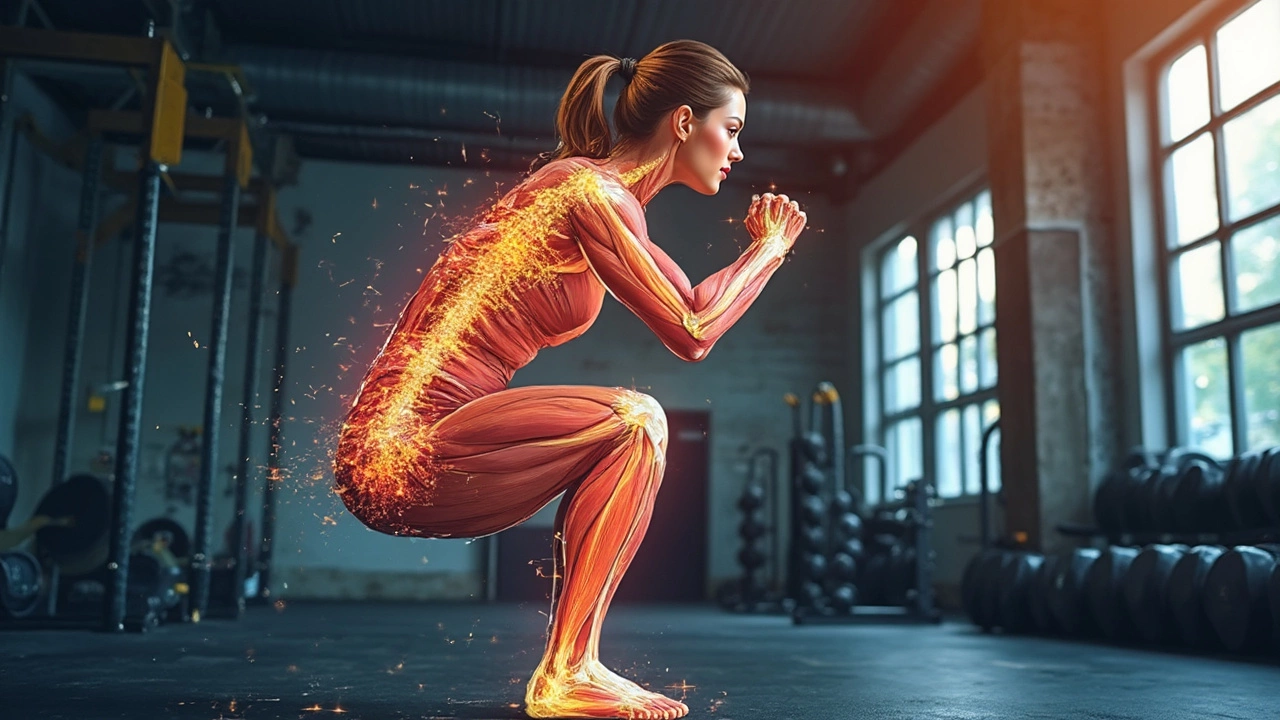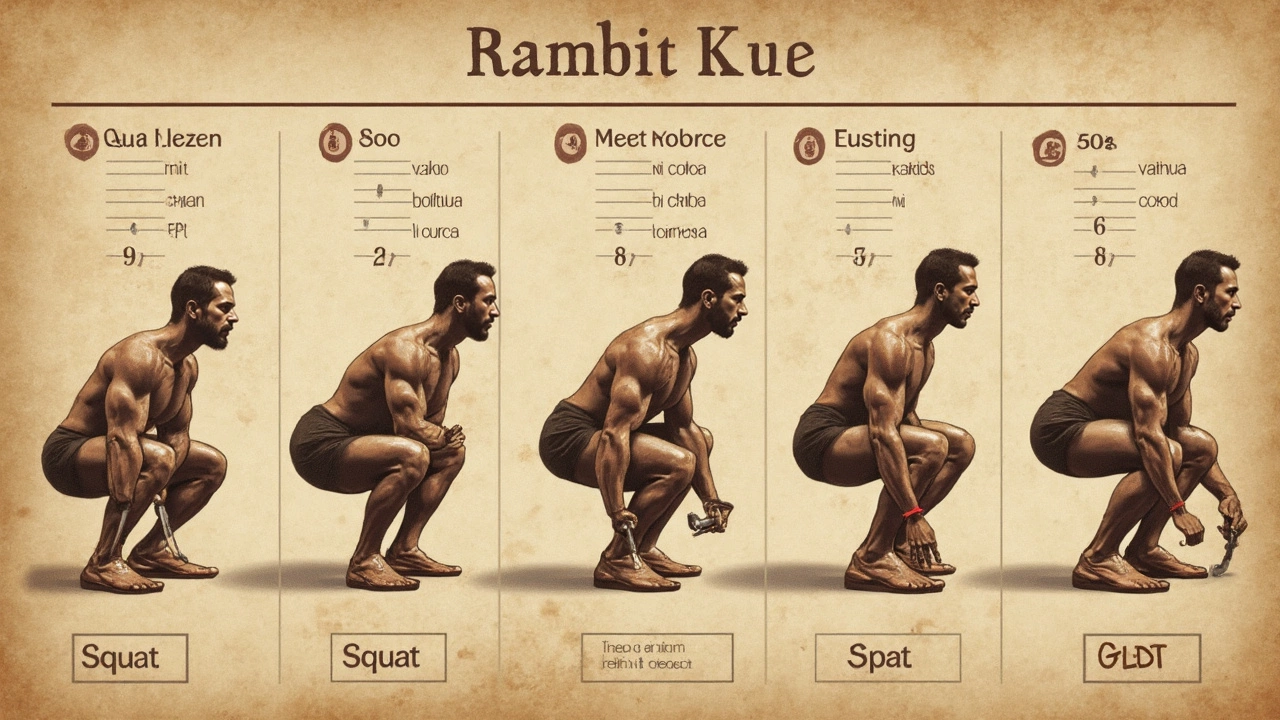Do Squats Work Your Whole Body?
 Apr, 15 2025
Apr, 15 2025
You might think squats are just about building killer quads, but there's more to them than meets the eye. Squats work on a whole lot of muscles, making it a fantastic exercise for overall strength. They hit the major muscle groups like your thighs, glutes, and core, but the ripple effect touches parts you wouldn't even expect.
Here's the kicker: when you squish it all together—proper technique, regular practice, and some cool variation—they can practically transform your routine into a sneaky full body workout. It’s not just about the legs; if done right, you’re shaving time and doubling efficiency.
But don’t just jump into it blindly. Getting the squat right is crucial. Bad form can lead to injuries faster than you can say 'Ouch!' Don’t worry though, perfecting your squat and knowing how to fit it into your workout can be a game-changer, promising gains without the pain.
- The Basic Squat Breakdown
- Squats and Muscle Engagement
- Benefits Beyond Muscle Building
- Perfecting Your Squat Form
- Variations to Try
- Incorporating Squats Into Your Routine
The Basic Squat Breakdown
Squats are a powerhouse move in the gym world. They might seem simple, but they pack a punch when it comes to strength training. The primary focus is on the lower body, with an impressive lineup of muscles that get involved every time you drop into a squat.
At the top of the list, squats target your quads and glutes. These are the major movers making sure you get back up once you’re down low. You're also working those hamstrings and calves, which play crucial roles in stabilizing and balancing your movements.
But the party doesn’t stop there. Your core muscles are on high alert during squats too, keeping your torso stable and strong, which is excellent news if you're aiming for a full-bodied workout. Squats also create some bonus action in your lower back, which helps in maintaining proper posture.
Now, if you're a numbers person, let’s break it down into some useful steps. Here's how to do a basic squat like a pro:
- Stand with your feet shoulder-width apart, toes slightly pointed out. This position helps with balance.
- Keep your chest up and spine straight—your eyes should be looking forward, not down.
- Bend your knees while pushing your hips back like you're going to sit in a chair. Lower yourself until your thighs are parallel to the floor.
- Make sure your knees don’t push past your toes. This keeps the pressure off your knees and lets your glutes do the work.
- Push through your heels to get back to the starting position.
Keeping these steps in mind ensures you are maximizing the effectiveness of the squat without risking injury. Consistency and precision go a long way, and soon enough, you'll be squatting like a pro, reaping all the benefits this classic exercise has to offer.
Squats and Muscle Engagement
When you drop into a squat, it’s not just your legs doing the heavy lifting. Squats are like the Swiss Army knife of gym exercises, engaging a surprising number of muscles across your body. From the moment you bend your knees, your quads are activated, but there's so much more going on.
Your glutes and hamstrings kick in to lower and lift your body, while your calf muscles help stabilize your lower legs. Feeling the burn in your core? That's because your abs and lower back muscles are pulling their weight, giving you a nice stability workout, too.
For a visual breakdown, let’s take a peek at what’s happening during a squat:
| Muscle Group | Primary Function |
|---|---|
| Quads | Main drivers for bending and straightening your knees. |
| Glutes | Support lower body movement and help with back support. |
| Hamstrings | Assist in hip movement and knee flexion. |
| Core | Provide stability and support to your spine. |
| Calves | Stabilize ankles and help control movement. |
You might not picture them right away, but some sneaky upper body muscles, like your traps and lats, get called into action to help stabilize your form, especially when you add weights to your squat game. That’s a lot of bang for your buck!
Because squats are so versatile, they’re perfect if you need to squeeze the most out of your workout in a jam-packed schedule. It’s like ordering one meal and getting a buffet. Plus, since squats mimic everyday activities—think sitting and standing—they’re hugely functional, helping you move better in real life.
Benefits Beyond Muscle Building
Squats aren’t just about beefing up those thighs and glutes. There’s a whole world of benefits hiding beneath this humble exercise. For starters, squats are like the secret sauce for improving your mobility and balance. Every time you squat, your core muscles are engaged, acting like nature's internal stabilizers. This is especially handy as you, er, mature in age.
Plus, these squats are great for boosting your metabolism. That’s right, not only are you burning calories by doing them, but they also rev up your calorie furnace for hours after you’re done. So the next time you plop down on the couch for Netflix, remember those squats are still silently working on your burn.
Strengthening the lower body helps with more than just lifting heavy things—or managing a flight of stairs without huffing and puffing. It’s about confidence! Confidence to climb, jump, and just get through the day with more ease. And as crazy as it sounds, being strong on your feet translates to mental oomph.
According to Dr. Miranda Holder from the University of Fitness, "Strong legs provide a foundation not only for physical strength but also for mental resilience."
And let’s not forget about bone health. When you perform weight-bearing exercises like squats, you’re actually helping to prevent bone-related issues. Engaging those muscles puts stress on your bones, which promotes bone density and reduces the risk of osteoporosis. It's like giving your future self a gift card for stronger bones!
- Improves balance and mobility
- Boosts metabolism long after workouts
- Builds strong mental and physical resilience
- Promotes bone health
So, the next time you see someone hitting the squat rack a bit too religiously, remember it’s not just about muscle size. It’s about crafting an all-rounded, better-performing you. Whether you’re into lifting or just keeping things efficient and effective, squats have got you covered.

Perfecting Your Squat Form
Nailing the squat form is crucial for maximizing all those juicy benefits while avoiding injuries. You don't want to be that person at the gym with a bad back just because of poorly executed squats, right? Let's get into the nitty-gritty of getting your form spot on.
Start by keeping your chest up and your back straight; this isn't just for looking sharp, it's to protect that precious spine of yours. Imagine there's a string pulling your head up to the ceiling. Your feet should be shoulder-width apart, maybe slightly wider if that's more comfortable. Toes? Keep them pointing forward or slightly outwards. It depends on what feels natural, but never force them into a specific position.
When you bend at the knees, remember to push your hips back as if you're about to sit on an invisible chair. This helps to keep your weight centered over your heels, reducing the chance of toppling forward. Speaking of knees, these should track over your toes. If you notice them caving inwards, realign with your toes to avoid knee strain.
While lowering your body, go as deep as your flexibility allows. Ideally, your thighs should be parallel to the ground, but listen to your body—everyone's flexibility is different. If you feel discomfort or pain, it's okay to modify the depth. And don’t forget to engage your core; it keeps you stable and supports the lift.
- Stand tall with feet shoulder-width apart.
- Push hips back as you bend your knees.
- Keep chest up and core engaged.
- Lower until thighs are parallel to the ground.
- Return to start by pushing through heels.
Even if squats work your whole body, focusing on proper form enhances effectiveness and keeps you safe. If you want extra assurance you're doing it right, try watching a mirror or filming yourself during a workout. This way, you can notice and correct any mistakes. Remember, consistency and patience are key, so keep practicing!
Variations to Try
If you're getting bored with your regular squats or need to amp things up, diving into some variations might be exactly what you need. These tweaks not only keep things interesting but also activate different muscle groups, turning a full-body workout into, well, an even fuller one. Let's check out some fun options.
- Goblet Squat: Hold a dumbbell or kettlebell close to your chest, and then squat. This variation focuses on your upper back and core a tad more than the regular squat. It's a great way to ease into weighted squats without needing a bar.
- Sumo Squat: Stand with your feet wider than shoulder-width apart and your toes pointing outwards, like a sumo wrestler. This targets your inner thighs and glutes differently than the standard stance.
- Jump Squat: Add a little hop to the top of your squat. This is all about power and will get your heart rate up in no time. Perfect for those cardio days when you're mixing it with strength training.
- Bulgarian Split Squat: Rest one foot on a bench behind you and squat with the other leg. It’s almost like a lunge, but with a killer twist. This targets your quads and glutes super effectively, adding balance and coordination to the mix.
- Overhead Squat: Hold a barbell over your head as you squat. Keeping it stable is a core-blaster, not to mention how much it engages your shoulders and back.
Mixing these variations in with regular squats ensures you don't overwork specific muscles and helps prevent plateauing. Plus, your body starts guessing what's next, keeping workouts dynamic and fresh! Try incorporating a couple of these into your routine each week and see how they boost your gym exercises game.
Incorporating Squats Into Your Routine
So you're sold on the benefits of squats, but now you're probably wondering how to make them a staple in your workout scene. First things first, it all starts with planning. You don't need to squat every day to see results, but a couple of times a week is a solid start.
When including squats, think of them as the main dish in a meal. They go well with almost everything. Whether you're doing cardio, strength training, or even yoga, adding them can enhance your body’s balance and power.
Setting up a simple routine can go a long way. Here’s a basic template to get you started:
- Strength Days: Aim for about 3-4 sets of 8-12 reps. Go at a weight that challenges but doesn’t exhaust you.
- Cardio Days: Try bodyweight squats as a part of your warm-up.
- Rest Days: Light squats can still help in maintaining that good form. Keep it low-key with no added weights.
Don’t forget to mix it up. Trying different squat variations can prevent boredom and help in hitting various muscle groups. From goblet squats to jump squats, keep experimenting!
Here's a quick look at how squats benefit your body:
| Muscle Group | Primary Focus |
|---|---|
| Quads | Primary |
| Glutes | Primary |
| Hamstrings | Secondary |
| Core | Stability |
Remember, regardless of your current fitness level, incorporating squats into your routine can gear you towards better strength and flexibility. And hey, listen to your body. It knows best when to push forward and when to pull back.